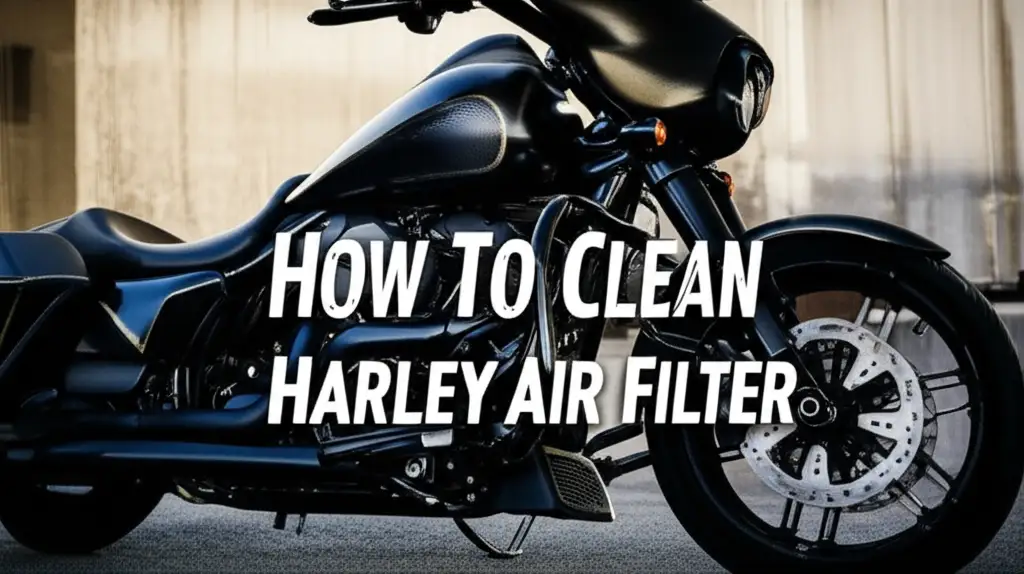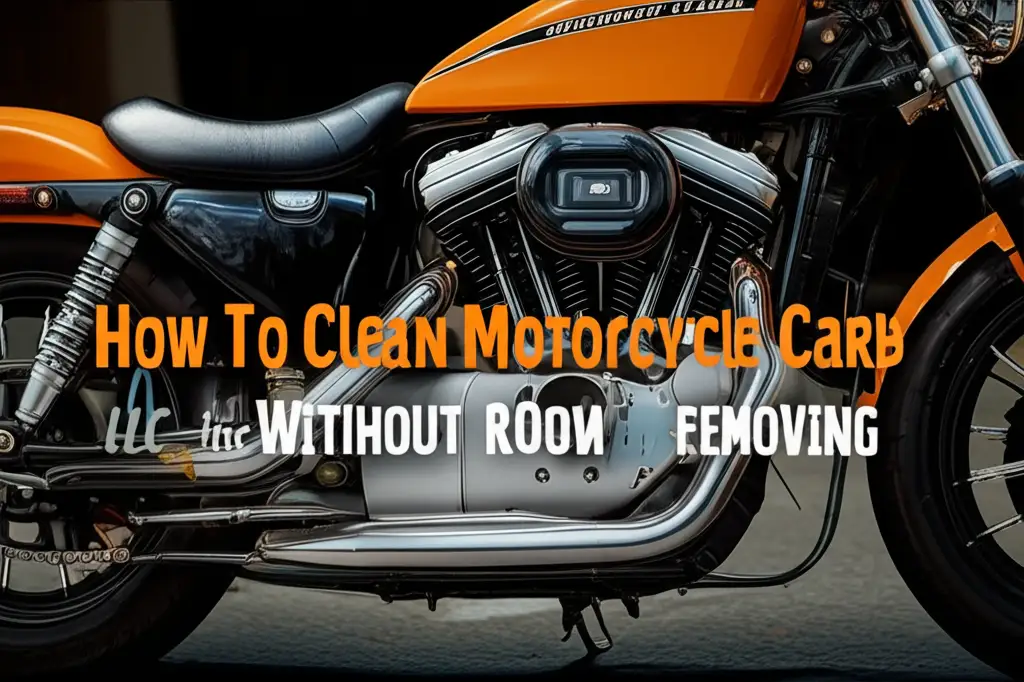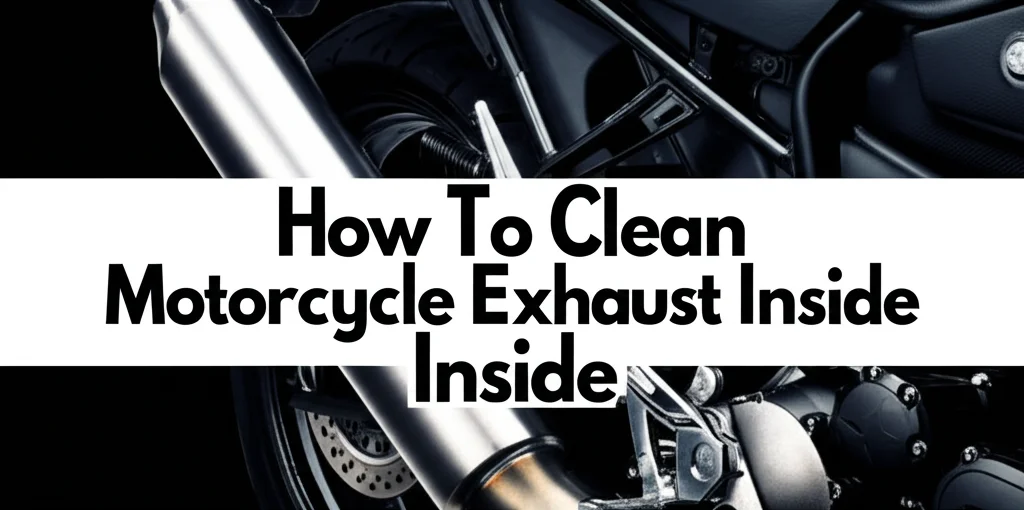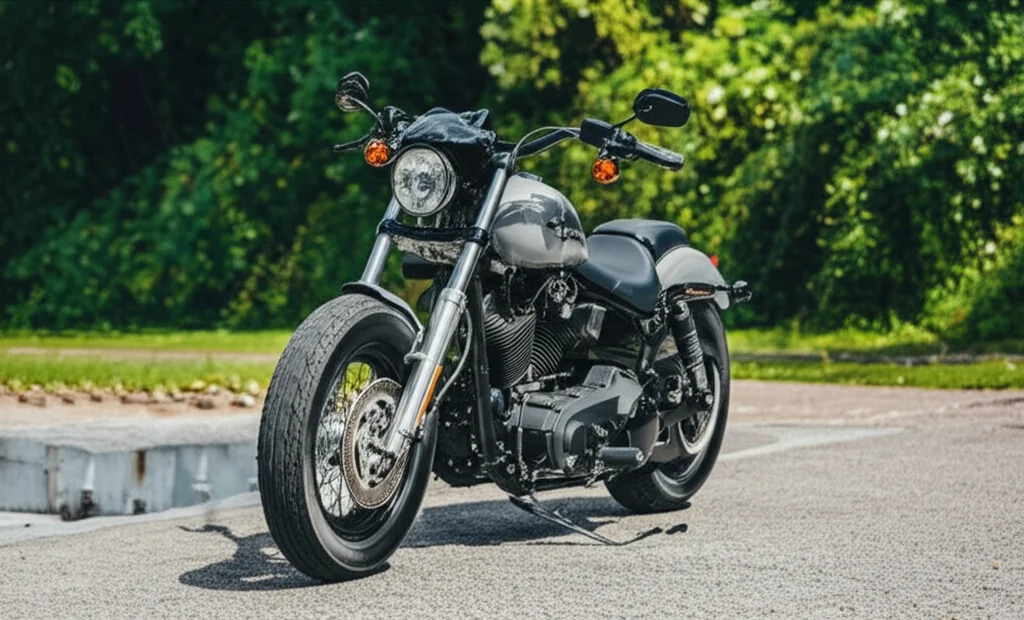· Motorcycle Maintenance · 17 min read
How To Clean Harley Air Filter

Clean Your Harley Air Filter: Boost Performance
Riding a Harley Davidson brings a feeling unlike any other. The rumble of the engine, the open road ahead – it is a truly special experience. To keep that experience optimal, proper maintenance is key. One vital task often overlooked is cleaning your Harley air filter. A clean air filter helps your engine breathe better. This leads to improved power and better fuel use.
I know how important it is to keep my bike running strong. That is why I always make sure my Harley air filter is clean. This simple task can make a big difference in how your motorcycle performs. In this guide, I will show you how to clean your Harley air filter step-by-step. We will cover filter types, necessary tools, and the full cleaning process. We will also discuss when to clean and when to replace your filter. Let us get your Harley running at its best.
Takeaway
- Regularly cleaning your Harley air filter improves engine power.
- Identify your specific Harley air filter type before you begin cleaning.
- Gather all necessary cleaning tools and solutions for your filter.
- Follow precise steps for cleaning and proper re-oiling (if applicable).
- Correct filter maintenance helps your Harley engine last longer.
How do you clean a Harley air filter?
To clean a Harley air filter, first remove it from its housing. Use a specialized cleaning solution for oiled filters, rinsing gently until clean. For dry paper filters, tap out loose dirt and use low-pressure compressed air from the inside out. Allow all filters to dry completely. Re-oil oiled filters correctly before reinstalling them. This boosts engine efficiency.
Why a Clean Harley Air Filter Is Crucial
Your Harley Davidson engine needs clean air to run well. The air filter works like a lung for your motorcycle. It stops dirt, dust, and debris from entering the engine. If the filter becomes clogged, it restricts airflow. This is like trying to run a race while holding your breath. The engine cannot perform at its best.
A dirty air filter impacts your Harley in several ways. First, it can lower your engine’s power output. You might notice less acceleration or a feeling of sluggishness. Second, it can hurt your fuel economy. A restricted engine often burns more fuel to try and compensate for the lack of air. This means more stops at the gas station and higher running costs. Third, and most serious, a dirty filter can cause engine damage. Particles bypass the filter and scratch internal engine parts. This leads to costly repairs over time. Keeping your air filter clean is a simple step. It protects your engine and ensures a smooth ride. Regular filter maintenance is a core part of keeping your motorcycle healthy. It helps you avoid bigger problems later on. A clean filter ensures a consistent, powerful ride every time. It is a smart investment in your Harley’s longevity. You can learn more about general motorcycle air filter care here: How To Clean Air Filter Motorcycle.
Identifying Your Harley Air Filter Type
Before you start cleaning, you must know your Harley air filter type. Harleys typically use one of two main kinds: oiled filters or dry filters. Knowing which type you have is important. The cleaning process for each is very different. Using the wrong method can damage the filter. It can also hurt your engine.
Oiled filters often have a cotton gauze material. Brands like K&N are common examples. This material is coated with a special oil. The oil traps tiny dirt particles. These filters are reusable. You clean them, re-oil them, and put them back in. When you touch an oiled filter, it feels slightly sticky or damp. You will often see a red or blue tint from the oil. If your filter has a metal mesh or fabric-like texture, it is likely an oiled filter. Many aftermarket filters for Harleys are of this type.
Dry filters are usually made of paper or a synthetic material. They look like pleated paper. These filters capture dirt in their fibers. Most car filters are dry type. Some stock Harley filters are also dry. They are not designed to be oiled. If you try to oil a dry filter, you will ruin it. When you touch a dry filter, it feels like thick paper. It will not feel oily or sticky. If your filter is white, yellow, or off-white and feels like cardboard, it is a dry filter. Always check your Harley’s owner’s manual. It will tell you the specific type of air filter your model uses. This step is critical for proper cleaning. Cleaning a dry filter is often simpler. You can find more information on cleaning some oiled filter types here: How To Clean Spectre Air Filter. And for foam filters, which also often use oil, check out: How To Clean Foam Air Filter.
Gathering Your Harley Air Filter Cleaning Supplies
Having the right tools makes the cleaning process easy. Before you start, gather everything you need. This prevents interruptions and ensures a smooth job. Using the correct products also protects your filter and your Harley’s engine. Do not try to use household cleaners not made for air filters. They can damage the filter material.
Here is a list of essential items:
- Air Filter Cleaning Kit: For oiled filters, a specific cleaning kit is a must. These kits come with a cleaner solution and a re-oiling agent. K&N makes popular kits, and they work for many cotton gauze filters. The cleaner breaks down the dirt and old oil. The re-oiling agent replenishes the filter’s dirt-trapping ability.
- Mild Detergent and Water (for some dry filters): Some dry, washable synthetic filters can use mild soap and water. However, most paper-element dry filters cannot. Always check your manual or the filter manufacturer’s instructions.
- Soft Brush: A soft-bristle brush helps remove loose debris. Use it gently.
- Compressed Air: This is vital for cleaning dry filters. Use a low-pressure air compressor or a can of compressed air. Always blow air from the inside out to push dirt away.
- Gloves: Protect your hands from dirt, oil, and cleaning solutions.
- Safety Glasses: Protect your eyes from dirt and cleaning spray.
- Shop Rags or Old Towels: Useful for wiping up spills and protecting your work area.
- Drop Cloth or Cardboard: Place this under your work area. It catches drips and keeps your garage floor clean.
- Light Source: A flashlight helps you inspect the filter closely for damage.
Do not use harsh chemicals, gasoline, or strong detergents. These can break down the filter material. They can also leave residues that hurt your engine. Always use products designed for air filters. If you do not have a specific air filter cleaner, it is best to buy one. A clean filter is important for your Harley. Using the right supplies ensures you clean it properly.
Step-by-Step Oiled Harley Air Filter Cleaning
Cleaning an oiled Harley air filter is a straightforward process. Follow these steps carefully to ensure a thorough cleaning. This will restore your filter’s performance and protect your engine. Remember, patience is key, especially during drying and re-oiling.
Removal Process
- Access the Filter: First, locate your Harley’s air filter cover. It is usually on the side of the engine. You might need to remove a few screws or clips to get to it.
- Remove the Filter: Carefully unbolt or unclip the air filter element. Some filters might pull straight out. Others might twist. Be gentle. Do not force anything.
- Inspect for Damage: Once removed, hold the filter up to a light source. Look for tears, holes, or significant damage. If you see any, the filter needs replacement, not cleaning.
Applying Cleaner
- Spray the Cleaner: Take your air filter cleaning solution. Spray it generously onto both sides of the filter. Make sure to cover all pleats.
- Let it Soak: Allow the cleaner to soak for about 10 to 15 minutes. This gives the solution time to break down the dirt and old oil. Do not let the cleaner dry on the filter.
Rinsing
- Rinse with Low Pressure: Use cool, low-pressure water. Rinse the filter from the clean side (the inside) outwards. This pushes the dirt out of the filter.
- Continue Rinsing: Keep rinsing until the water runs clear. You will see dirty water coming off the filter at first. Be thorough but gentle. Do not use high-pressure water, as it can damage the filter material.
Drying
- Shake Off Excess Water: Gently shake the filter to remove excess water.
- Air Dry Only: Place the filter in a clean, dry area. Let it air dry completely. This can take several hours, or even a full day, depending on humidity. Do not use compressed air, heat guns, or direct sunlight to speed up drying. High heat can melt the filter’s glue. Compressed air can damage the delicate cotton fibers. Ensure it is bone dry before the next step.
Re-oiling
- Apply Oil Evenly: Once completely dry, it is time to re-oil. Use the specific air filter oil that came with your cleaning kit. Apply a thin, even coat of oil to each pleat. You can use a spray bottle or a squeeze bottle with a nozzle.
- Wait for Absorption: After applying the oil, wait about 20 minutes. The oil will wick and spread throughout the filter material.
- Check for Light Spots: Hold the filter up to a light again. Look for any light spots or areas that appear dry. Apply more oil to these spots if needed. Do not over-oil. Too much oil can restrict airflow. It can also get into your engine’s sensors. The filter should look evenly colored, not dripping wet.
This careful process ensures your oiled Harley air filter functions as intended. It provides maximum filtration and airflow. For more specific information on cleaning aftermarket oiled filters, you can refer to resources like How To Clean AEM Air Filter.
Detailed Guide to Cleaning Dry Harley Air Filters
Cleaning a dry Harley air filter element is different from cleaning an oiled one. Dry filters, typically made of paper or synthetic fibers, do not use oil. They capture dirt through their physical structure. Using water or oil on these filters will ruin them. The goal is to remove loose dirt without damaging the filter media.
Removal
- Access the Filter: Just like with oiled filters, locate and open your Harley’s air cleaner cover.
- Remove the Filter Element: Carefully unclip or unbolt the dry air filter. Handle it gently. Paper filters are fragile and can tear easily.
- Initial Inspection: Before any cleaning, visually inspect the filter. Look for any visible tears, holes, or heavily clogged areas. If the paper element is dark, heavily embedded with dirt, or damaged, it is best to replace it. Dry filters have a limited lifespan and are often considered non-washable.
Tapping and Brushing
- Tap Out Loose Debris: Hold the filter firmly and gently tap it against a hard surface. Do this outside or over a trash can. This helps dislodge large pieces of dirt and debris from the pleats. Do not hit it too hard. You do not want to damage the paper.
- Brush Off Surface Dirt: Use a soft-bristle brush. Gently brush along the pleats to remove any remaining loose dirt. Brush lightly. Do not scrub or push hard. This avoids embedding dirt deeper into the filter fibers.
Using Compressed Air
- Low-Pressure Air Only: This is the most effective method for cleaning a dry filter. Use a low-pressure air compressor. A can of compressed air for electronics can also work.
- Blow from Inside Out: Direct the compressed air stream from the inside of the filter towards the outside. This pushes the dirt out of the pleats. Work your way around the entire filter.
- Maintain Distance: Hold the nozzle a few inches away from the filter. Do not use high-pressure air or hold it too close. High pressure can tear the delicate paper element.
- Repeat as Needed: Continue blowing until no more dust comes out. The filter should appear much cleaner.
Final Inspection
- Check for Cleanliness and Damage: After cleaning, hold the filter up to a bright light. You should see light coming through the filter material. Look again for any small tears or thin spots. If the filter still looks very dirty, or if it is damaged, you should replace it.
- Do Not Wash: Reiterate: do not wash a dry paper air filter with water or any liquids. It will destroy the filter’s ability to filter air. It will cause severe engine damage.
Cleaning a dry filter is simpler than an oiled one. However, dry filters often need replacement more frequently than oiled, reusable filters. Many lawn mowers also use dry paper air filters, and the cleaning process is similar: How To Clean Air Filter On Lawn Mower. Similarly, some chainsaw air filters are dry, and require careful cleaning: How To Clean Chainsaw Air Filter.
Proper Reinstallation of Your Harley Air Filter
After cleaning and drying your Harley air filter, correct reinstallation is important. A filter that is not installed properly will not protect your engine. It can also cause performance issues. Take your time during this step to ensure everything is correct.
- Inspect the Airbox: Before you put the filter back, check the air filter housing. Wipe away any dust or debris inside the airbox. Make sure there are no loose parts or obstructions.
- Check Gaskets and Seals: Look at any rubber gaskets or seals on the filter or the housing. Make sure they are clean and not cracked or damaged. These seals create an airtight path for air. A damaged seal lets unfiltered air into the engine. Replace any damaged gaskets if necessary.
- Position the Filter Correctly: Place the cleaned air filter back into its housing. Ensure it sits perfectly flat and flush. There should be no gaps around the edges. Many filters have a specific orientation. Make sure you put it back the same way you took it out.
- Secure the Filter: Reinstall any bolts, clips, or clamps that hold the filter in place. Tighten them firmly but do not overtighten. Over-tightening can crack plastic parts or strip threads. Just make it snug.
- Reattach the Air Cleaner Cover: Put the air cleaner cover back on. Secure all screws or clips. Ensure the cover is tight and sealed. This prevents moisture and dirt from entering.
- Double-Check All Connections: Give everything a quick visual check. Make sure all hoses, wires, or sensors you might have disconnected are reattached. Ensure they are secure.
Post-Cleaning Checks
- Start the Engine: Once everything is back together, start your Harley. Listen for any unusual sounds. The engine should idle smoothly. A clean air filter often makes the engine sound a little crisper.
- Brief Test Ride: Take your Harley for a short ride. Pay attention to how it feels. You should notice improved throttle response and possibly better acceleration. If you hear any new strange noises or experience a drop in power, stop. Recheck the air filter installation.
Proper reinstallation ensures that the cleaned filter does its job. It protects your engine from harmful particles. It also allows for optimal airflow. This helps your Harley run at its best. Enjoy the ride knowing your engine is breathing clean air.
Knowing When to Clean or Replace Your Harley Filter
While cleaning your Harley air filter is important, it is not always the solution. Sometimes, a filter is too far gone, or it has reached the end of its life. Knowing when to clean versus when to replace is key for your Harley’s health.
How Often to Clean
The frequency of cleaning depends on several factors:
- Riding Conditions: If you ride often in dusty, dirty, or off-road environments, your filter will get dirty faster. You might need to clean it every 2,500 to 5,000 miles.
- Normal Conditions: For average street riding, cleaning every 5,000 to 10,000 miles is usually sufficient.
- Manufacturer Recommendations: Always check your Harley’s owner’s manual or the filter manufacturer’s guidelines. They provide specific service intervals.
- Visual Inspection: The best way to know is to visually inspect your filter regularly. Pull it out every few thousand miles or before long trips. If it looks dirty, clean it.
Signs of a Dirty Filter
Your Harley will often tell you if its air filter needs attention:
- Decreased Engine Performance: The bike feels sluggish. It has less power or takes longer to accelerate.
- Reduced Fuel Economy: You are getting fewer miles per gallon than usual. A dirty filter makes the engine work harder, using more fuel.
- Rough Idling: The engine might run unevenly or sputter when stopped.
- Black Smoke from Exhaust: This can happen if the engine is getting too much fuel and not enough air. It leads to incomplete combustion.
- Engine Warning Light: In newer models, a heavily restricted air filter might trigger a check engine light.
When to Replace Your Filter
Cleaning can prolong the life of reusable filters. However, even reusable filters eventually wear out. Dry paper filters are typically replaced, not cleaned.
- Damage: If you see any tears, holes, cracks, or deep gouges in the filter material, replace it immediately. Even a small hole lets unfiltered air directly into your engine.
- Excessive Dirt Buildup: If a dry filter is completely black or saturated with dirt that cannot be removed by tapping or blowing, replace it.
- Wear and Tear: Oiled filters, even after many cleanings, can degrade. The pleats might start to collapse. The rubber seals might harden or crack. If the filter no longer holds its shape, it is time for a new one.
- Age: Over time, filter materials can degrade regardless of use. Follow manufacturer recommended replacement intervals, especially for dry filters.
- After Cleaning Several Times: Even with proper cleaning, a reusable filter has a finite number of cleanings. After many cycles, the material might lose its effectiveness.
Regular checks are the best way to monitor your Harley’s air filter. Cleaning it when needed keeps your engine happy. Replacing it when necessary protects your investment. This simple maintenance step greatly improves your riding experience.
FAQ Section
Q1: How often should I clean my Harley air filter?
You should typically inspect your Harley air filter every 2,500 to 5,000 miles. For riders in dusty areas, cleaning might be needed more often. Under normal street conditions, cleaning every 5,000 to 10,000 miles is common. Always check your Harley’s owner’s manual for specific recommendations tailored to your model and riding style. Regular visual checks are always best.
Q2: Can I use dish soap to clean my Harley air filter?
No, you should not use dish soap to clean an oiled Harley air filter. Dish soap can be too harsh for the delicate cotton fibers. It can also leave residues that affect the filter’s performance or clog it. Always use a dedicated air filter cleaning solution. These solutions are formulated to safely remove dirt and old oil without harming the filter material.
Q3: What happens if I over-oil my Harley air filter?
If you over-oil your Harley air filter, it can cause problems. Excess oil can restrict airflow, making your engine run “rich” (too much fuel, not enough air). This can lead to reduced power and poor fuel economy. More seriously, excess oil can get sucked into the engine and coat sensitive sensors, like the mass airflow sensor, causing malfunctions and potentially triggering a check engine light.
Q4: How do I know if my Harley air filter needs cleaning?
You can tell if your Harley air filter needs cleaning by performing a visual inspection. If it looks visibly dirty, clogged with debris, or discolored, it likely needs cleaning. Other signs include decreased engine power, reduced fuel efficiency, a rough-running engine, or black smoke coming from the exhaust. Do not wait until performance drops significantly.
Q5: Can cleaning my air filter improve gas mileage?
Yes, cleaning your air filter can improve your Harley’s gas mileage. A dirty air filter restricts the amount of air reaching the engine. This makes the engine work harder to draw in air. When the engine works harder, it uses more fuel. By cleaning your filter, you restore proper airflow. This allows the engine to run more efficiently, often resulting in better fuel economy.
Q6: Is it better to clean or replace a Harley air filter?
It depends on the filter type and condition. Oiled filters (like K&N) are designed to be cleaned and reused multiple times. Dry paper filters are generally meant for replacement when dirty or damaged, as cleaning them with water or harsh methods can destroy them. If any filter, oiled or dry, has tears, holes, or deep damage, replacement is always the better option for engine protection.
Conclusion
Keeping your Harley Davidson’s air filter clean is a simple yet crucial maintenance task. It directly impacts your motorcycle’s performance, fuel efficiency, and long-term engine health. By following the steps in this guide, you can confidently clean your Harley air filter yourself. This avoids costly shop visits and keeps your ride running strong. Remember to identify your filter type and use the correct cleaning method. This ensures proper
- harley air filter cleaning
- motorcycle maintenance
- harley davidson care
- bike air filter
- engine performance
- diy motorcycle




